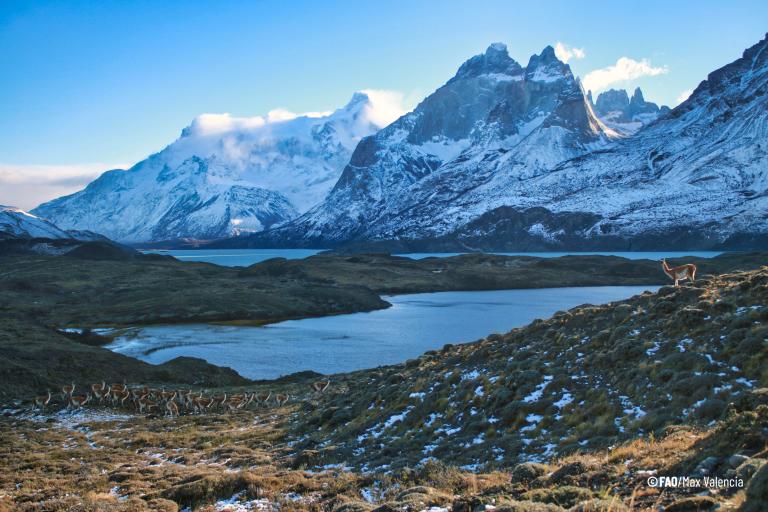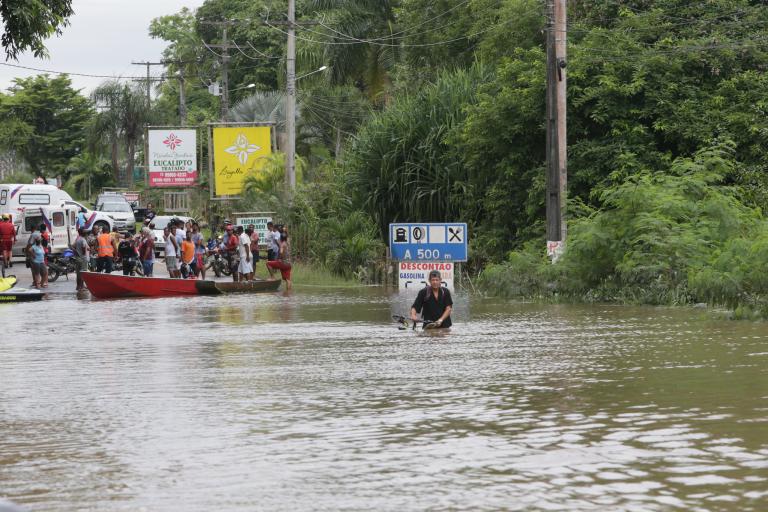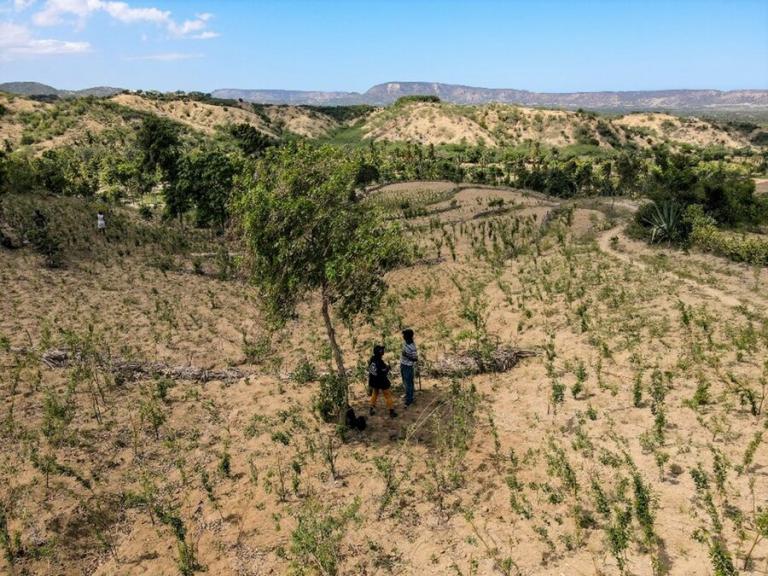WMO issues report State of Climate in Latin America and Caribbean
Extreme weather and climate change impacts including mega-drought, extreme rainfall, land and marine heatwaves and glacier melt are affecting the Latin America and the Caribbean region, from the Amazon to the Andes and from Pacific and Atlantic Ocean waters to the snowy depths of Patagonia.

Cartagena/Geneva, 22 July 2022 (WMO) - Extreme weather and climate change impacts including mega-drought, extreme rainfall, land and marine heatwaves and glacier melt are affecting the Latin America and the Caribbean region, from the Amazon to the Andes and from Pacific and Atlantic Ocean waters to the snowy depths of Patagonia.
The World Meteorological Organization (WMO) State of the Climate in Latin America and the Caribbean 2021 highlighted the far-reaching repercussions for ecosystems, food and water security, human health and poverty.
Deforestation rates were the highest since 2009, in a blow for both the environment and climate change mitigation. Andean glaciers have lost more than 30 percent of their area in less than 50 years. The “Central Chile Mega drought” is the longest in at least 1,000 years.

“The report shows that hydrometeorological hazards, including droughts, heatwaves, cold waves, tropical cyclones and floods, have unfortunately led to the loss of hundreds of lives, severe damages to crop production and infrastructure and human displacement” said WMO Secretary-General Prof. Petteri Taalas.
“Increasing sea-level rise and ocean warming are expected to continue to affect coastal livelihoods, tourism, health, food, energy, and water security, particularly in small islands and Central American countries. For many Andean cities, melting glaciers represent the loss of a significant source of freshwater currently used for domestic use, irrigation, and hydroelectric power. In South America, the continued degradation of the Amazon rain forest is still being highlighted as a major concern for the region but also for global climate, considering the role of the forest in the carbon cycle,” said Prof. Taalas.
The report was released during a WMO Regional Technical Conference for South American countries, organized by WMO in Cartagena, Colombia, on 22 July 2022.This is the second year that WMO has produced this annual regional report, which provides decision-makers more localized information to inform action. It is accompanied by an interactive Story Map.
“Worsening climate change and the compounding effects of the COVID-19 pandemic have not only impacted the biodiversity of the region, but have also stalled decades of progress against poverty, food insecurity and the reduction of inequality in the region,” said Dr. Mario Cimoli of Economic Commission for Latin America and the Caribbean (ECLAC).
“Addressing such interconnected challenges and their associated impacts will require an interconnected effort. No matter how it is taken, action must be informed by science. The State of the Climate in Latin America and the Caribbean report, the second of its kind, is a critical source of science-based information for climate policy and decision-making. ECLAC will continue to play an active role in this dissemination of weather and climate information to foster more partnerships, improved climate services and stronger climate policy across Latin America and the Caribbean,” he said.
Key findings:
- Temperature: The warming trend continued in 2021 in Latin America and the Caribbean. The average rate temperature increase was around 0.2°C/decade between 1991 and 2021, compared to 0.1°C/decade between 1961 and 1990.
- Glaciers in the tropical Andes have lost 30% and more of their area since the 1980s, with a negative mass balance trend of -0.97 m water equivalent per year during the 1990-2020 monitoring period. Some glaciers in Peru have lost more than 50% of their area. Glacier retreat and the corresponding ice-mass loss has increased the risk of water scarcity for the Andean population and ecosystems.
- Sea levels in the region continued to rise at a faster rate than globally, notably along the Atlantic coast of South America south of the equator (3.52 ± 0.0 mm per year, from 1993 to 2021), and the subtropical North Atlantic and the Gulf of Mexico (3.48 ± 0.1 mm per year, from 1993 to 1991). Sea level rise threatens a large proportion of the population, which is concentrated in coastal areas—by contaminating freshwater aquifers, eroding shorelines, inundating low-lying areas, and increasing the risks of storm surges.
- The “Central Chile Mega Drought” continued in 2021, at 13 years to date, this constitutes the longest drought in this region in at least one thousand years, exacerbating a drying trend and putting Chile at the forefront of the region’s water crisis. Additionally, a multi-year drought in the Parana-La Plata Basin, the worst since 1944, affected central-southern Brazil and parts of Paraguay and Bolivia.
- The Parana-La Plata basin drought-induced damages to agriculture reduced crop production, including soybean and corn, affecting global crop markets. In South America overall, drought conditions led to a decline of -2.6% in the 2020-2021 cereal harvest compared with the previous season.
- The 2021 Atlantic Hurricane season had the third highest number of named storms on record, 21, including seven hurricanes, and was the sixth consecutive above-normal Atlantic hurricane season. Some of these storms directly impacted the region.
- Extreme rainfall in 2021, with record values in many places, led to floods and landslides. There were substantial losses, including hundreds of fatalities, tens of thousands of homes destroyed or damaged and hundreds of thousands of people displaced. Floods and landslides in the Brazilian states of Bahia and Minas Gerais led to an estimated loss of US$ 3.1 billion.
- Deforestation in the Brazilian Amazon rainforest doubled compared to the 2009‑2018 average, reaching its highest level since 2009. 22% more forest area was lost in 2021 compared to 2020.
- A total of 7.7 million people, in Guatemala, El Salvador and Nicaragua, experienced high levels of food insecurity in 2021, with contributing factors including continuing impacts from hurricanes Eta and Iota in late 2020 and COVID-19 pandemic economic impacts.
- The Andes, northeast Brazil and the northern countries in Central America are among the most sensitive regions to climatic-related migrations and displacements, a phenomenon that has increased in last 8 years. Migration and population displacement have multiple causes. Climate change and associated extreme events are amplifying factors, which exacerbate social, economic and environmental drivers.
- South America is among the regions with the greatest documented need for strengthening of early warning systems. Multi-hazard early warning systems (MHEWS) are essential tools for effective adaptation in areas at risk from weather, water and climate extremes.
Reasons of concern and knowledge gaps

The IPCC Sixth Assessment Report shows how precipitation patterns are shifting, temperatures are rising, and some areas are experiencing changes in the frequency and severity of weather extremes such as heavy rains.
The two great oceans that flank the continent—the Pacific and the Atlantic—are warming and becoming more acidic as a result of carbon dioxide while sea level also rises.
Unfortunately, greater impact is in store for the region as both the atmosphere and ocean continue to rapidly change. Food and water supplies will be disrupted. Towns and cities and the infrastructure required to sustain them will be increasingly at risk.
Human health and welfare will be adversely affected, along with natural ecosystems. Amazonia, northeastern Brazil, Central America, the Caribbean, and some parts of Mexico will likely see increased drought conditions, while hurricanes impacts may increase in Central America and the Caribbean. Climate change is threatening vital systems in the region, such as the glaciers in the Andes, the coral reefs in Central America, the Amazon forest, that are already approaching critical conditions under risk of irreversible damage.
In addition to impacts from the COVID-19 pandemic, in the LAC region the United Nations Office for Disaster Risk Reduction registered a total of 175 disasters during the 2020-2022 period. Of these, 88% have meteorological, climatological and hydrological origins. These hazards accounted for 40% of recorded disaster-related deaths and 71% of the economic losses.
To reduce adverse impacts of climate-related disasters and support resource management decisions and improved outcomes, climate services, end-to-end early warning systems, and sustainable investments are required but are not yet adequately deployed in the LAC region.
It is vital to strengthen the climate services value chain across its constituent components – including observing systems, data and data management, better forecasting, strengthening of weather services, climate scenarios, projections, and climate information systems
Notes to Editors
WMO extends its gratitude for all the dedicated hard work from WMO’s network of experts who ensure that this report is an authoritative source of information. We are especially grateful to Dr Jose Marengo of Brazil’s National Centre for Monitoring and Early Warning of Natural Disasters who acted as lead author.
Information used in this report is sourced from a large number of National Meteorological and Hydrological Services (NMHSs) and associated institutions, as well as Regional Climate Centres.
The following UN agencies, international and regional institutions contributed :
Economic Commission for Latin America and the Caribbean (ECLAC, or CEPAL in Spanish)
Food and Agriculture Organization of the United Nations (FAO)
United Nations Environment Programme (UNEP)
United Nations Office for Disaster Risk Reduction (UNDRR, formerly UNISDR)
United Nations Office for the Coordination of Humanitarian Affairs (OCHA)
United Nations Population Fund (UNFPA)
International Organization for Migration (IOM)
UNESCO Intergovernmental Hydrological Programme (IHP)
United Nations High Commissioner for Refugees (UNHCR)
UK Met Office
US National Oceanic and Atmospheric Administration (NOAA)
Global Precipitation Climatology Centre (GPCC)
Laboratory of Space Geophysical and Oceanographic Studies (LEGOS)
ECMWF Copernicus Climate Change Service (C3S)
International Centre for Research on the El Niño Phenomenon (CIIFEN)
Caribbean Institute for Meteorology and Hydrology (CIMH)
National Centre for Monitoring and Early Warning of Natural Disasters (CEMADEN)
The World Meteorological Organization (WMO) is a specialized agency of the United Nations responsible for promoting international cooperation in atmospheric science and meteorology.
WMO monitors weather, climate, and water resources and provides support to its Members in forecasting and disaster mitigation. The organization is committed to advancing scientific knowledge and improving public safety and well-being through its work.
For further information, please contact:
- Brigitte Perrin Head of Strategic Communications bperrin@wmo.int +41 79 513 05 12

